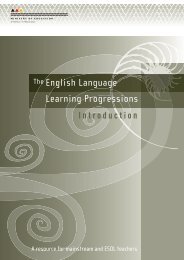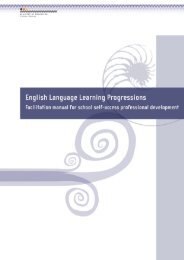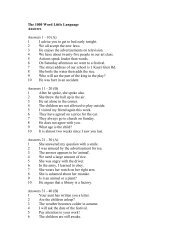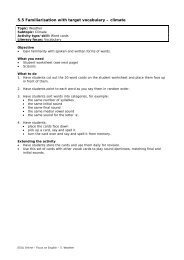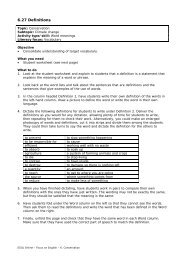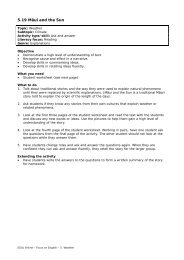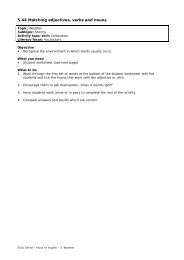Visual Arts Learning Progression and Assessment Methods (PDF
Visual Arts Learning Progression and Assessment Methods (PDF
Visual Arts Learning Progression and Assessment Methods (PDF
You also want an ePaper? Increase the reach of your titles
YUMPU automatically turns print PDFs into web optimized ePapers that Google loves.
<strong>Visual</strong> <strong>Arts</strong><strong>Learning</strong> <strong>Progression</strong><strong>and</strong><strong>Assessment</strong> <strong>Methods</strong>Sara WhitakerDunedin College of Educationsara.whitaker@dce.ac.nz
<strong>Visual</strong> <strong>Arts</strong><strong>Learning</strong> <strong>Progression</strong><strong>and</strong><strong>Assessment</strong> <strong>Methods</strong>Contents page Pg 1: <strong>Learning</strong> <strong>Progression</strong> Pg 2: <strong>Assessment</strong> methods Pg 3: Student teacher conversations Pg 4: Sample questions Pg 5: Work samples Pg 6: Written responses – <strong>Learning</strong> journals or visual diaries Pg 8: ObservationsAppendices Pg 9: Resources <strong>and</strong> references - Questioning Pg 10: References Pg 11: Class record of student arts achievement levels 1, 2 Pg 12: Class record of student arts achievement levels 3, 4
<strong>Visual</strong> <strong>Arts</strong> <strong>Learning</strong> <strong>Progression</strong> – Focus on CIThis progression is inclusive of learning across all four str<strong>and</strong>s, through a CI focus.Use when students are talking or writing about their own <strong>and</strong> others artworksEach stage builds upon <strong>and</strong> is inclusive of earlier stages.i Labels objectsGives brief (1-2 word) responses when promptedBegins to show awareness of mediaLevel 4Level 3Level 2Level 1iiiiiiiiiiiiiiTalks about what an artwork is aboutResponds to questions about artworkComments on discoveries made during explorationRecognises that artworks have a place <strong>and</strong> purpose in people’s livesTalks about aspects of an artwork <strong>and</strong> how <strong>and</strong> why it was madeBegins to link ideas in artwork to choices madeBegins to use some arts vocabularyExpresses ideas about effects <strong>and</strong> qualities of materials <strong>and</strong> processesDescribes an artwork, how it was developed <strong>and</strong> the ideas it conveysExplains the effect of 1-2 choices madeTalks about the purpose of specific artworks <strong>and</strong> their significance withina communityBegins to link choices (of techniques, materials, processes etc.), to waysof communicating ideasShows some evidence of planning <strong>and</strong> exploring ideas towards final workBegins to identify problems faced in making artworks <strong>and</strong> suggestpossible solutions.Describes ideas in work, <strong>and</strong> the relationship with techniques/processes.Explains how ideas were developedIdentifies use of elements <strong>and</strong> explains use of principles of composition.Investigates the purpose of artworks <strong>and</strong> talks about their contextUses introduced vocabulary when making <strong>and</strong> responding to artworksComments on a particular approach, (convention, procedure, or process)used in making objects <strong>and</strong> images.Begins to use, develop <strong>and</strong> recognise personal approaches, <strong>and</strong> explaintheir meaning or effectDescribes problems faced in producing work <strong>and</strong> how they were resolvedDescribes different kinds of ideas found in different artworksIdentifies ways artwork is influenced by artist model’s approachesExplains choice of materials, techniques, symbols <strong>and</strong> motifs to conveyintentionInvestigates the purposes of artworks <strong>and</strong> identifies their contextsUses introduced vocabulary consistently in making <strong>and</strong> responding toartworksExplains how ideas were initiated <strong>and</strong> developed in artworkDescribes evidence of conventions, used in the workShares findings about why <strong>and</strong> how an artwork conveys meaning/ideasPage 1
<strong>Assessment</strong> <strong>Methods</strong><strong>Assessment</strong> is integral to learning <strong>and</strong> achieving in the arts. Effective assessmentpromotes student learning, raises st<strong>and</strong>ards <strong>and</strong> reduces disparity of achievement.The <strong>Arts</strong> in the New Zeal<strong>and</strong> Curriculum, page 91<strong>Assessment</strong> which is explicitly designed to promote learning is the single mostpowerful tool we have for both raising st<strong>and</strong>ards <strong>and</strong> empowering lifelong learnersNational <strong>Assessment</strong> Strategy, online workshop, TKIThe intention is to: reinforce links between effective assessment practice, teaching <strong>and</strong> learning recognise opportunities for active teaching <strong>and</strong> assessment within learningexperiences in the arts classroom support teachers to gather evidence that informs their next steps <strong>and</strong> reportingTeachers need to: establish clear learning intentions share learning intentions <strong>and</strong> develop success criteria with students ensure multiple opportunities for students to revisit <strong>and</strong> achieve learningoutcomes allow regular opportunities for students to reflect on their achievement againstexpected learning outcomes <strong>and</strong> criteriaIn the following pages four assessment methods are described: Student-Teacher conversations Work samples Written responses ObservationsEach method is described separately to distinguish the nature of information to begained. The four methods recognise the opportunities that occur in the course offrequent teacher-learner interactions to provide students with helpful feedback <strong>and</strong>feedforward about their work. Within the classroom the four methods are likely tobe used informally, in combination.They utilise opportunities that exist within every classroom learning experience tocollect, analyse <strong>and</strong> use information to improve teaching <strong>and</strong> learning.Each assessment method provides a source of information to help identify astudent’s stage of development, deciding where they “best fit” within a learningprogression. Teachers should not use these assessment methods as discrete tools,but allow their judgement to be informed by a mix of all forms.Teachers using these methods will need to find efficient ways of recording <strong>and</strong>storing information gathered about student learning. Refer to <strong>Arts</strong> On-line (insertpage url) for examples.Page 2
Student–Teacher ConversationsGuidelines: Ask open-ended questions that relate specifically to the work under discussion Be prepared to wait 3-5 seconds for students to answer Genuinely listen to <strong>and</strong> build on student responses Ask students to clarify, elaborate or extend on initial responses Ask children to explain the choices they have made in their work. Provideprompts, e.g., “I like these fine wispy lines here … Why did you …?” Use child appropriate vocabulary but include specific visual arts vocabularyintroduced for the learning in progress Link questions directly to key learning intentions from the unit of work. Refer toFocus Questions in Pasifika <strong>and</strong> Māori <strong>Visual</strong> Culture resources. Ask students to describe their learning against the success criteria Ensure students have regular opportunities to reflect on their achievement.Possible question startersTell me about . . . ?How did you decide . . .?Can you explain . . . ?The sample questions on the following page are examples of the types of questionsyou might ask students. Use them as a guide only. Make your questions specific tothe context of the artwork <strong>and</strong> responsive to the student’s comments.Broad questions are most likely to elicit level 1-2 responses.More specific questions are most likely to elicit level 2-3 responses.Focused indepth questions are most likely to elicit level 3-4 responses.Student responses to questions will help teachers to determine the student’sworking level <strong>and</strong> identify their “best fit” within the learning progression.Page 3
BROADTell me aboutyour artwork.If you weremaking thisartwork againwhat would youchange?How did youdecide wherethings wouldgo?What do youthink aboutthe artist’swork?Tell me aboutthe materialsyou used. Howdid you usethem?What are youpleased aboutin your artwork? Why?How did youmake thosecolours (lines,shapes, etc.),<strong>and</strong> why ?GENERALWhat are themain ideas inyour (theartist’s) work?Describe the techniques<strong>and</strong> processes you haveused with materials <strong>and</strong>tools. Did you get anyideas from the artist?How have youarranged <strong>and</strong>combined lines <strong>and</strong>shapes etc tocommunicate ideas?What do youlike about thematerials youhave used?What decisionsdid you make?Are you pleasedwith them?Is there a mainfocus? How doesthat work?SPECIFICHow have arrangedyour art work(elements, principles)so the viewerunderst<strong>and</strong>s the mainideas?How did you developthe ideas for yourart work?Can you explain whyyou used……?How have youused techniques<strong>and</strong> processes?What effects didthis create?In what ways hasyour work beeninfluenced by otherartists or artmaking practices?What problems didyou face? Whatwere your otheroptions?How have yourefined yourunderst<strong>and</strong>ing ofmaterials <strong>and</strong>techniques?Page 4
Work Samples• Can provide information about student achievement across all four str<strong>and</strong>s• Can provide a focus for discussion <strong>and</strong> reflection, complete or in progress• Should reflect student learning at various stages of the art-making process.• Are best considered in conjunction with other assessment methods,especially students’ verbal or written comments.• Should consist of related works <strong>and</strong> activities (not isolated examples)• Should be considered in relation to shared learning intentionsWork samples could include:- drawings to develop ideas <strong>and</strong> imagery- drawings to plan composition- explorations of techniques, materials etc.- exploration of the use of elements <strong>and</strong> principles to convey ideas- reflections on final work – against SLO’s <strong>and</strong> success criteria- completed works, (single or a series)Note: Students’ reflective comments provide information about their learning <strong>and</strong>reveal when choices have been conscious <strong>and</strong> deliberateWhich aspects of a student’s development can we determine from work samples?Key Principles, informing progressionThese five key principles can be seen to underpin assessment <strong>and</strong> characterizeprogression in the arts.Complexity: students revisit concepts <strong>and</strong> skills in increasingly complex <strong>and</strong>sophisticated waysControl: students acquire increasing control in using art forms as a medium ofexpression <strong>and</strong> communicationDepth: Students move from exploring a broad range of arts experiences toengaging with more specific aspects in more depthIndependence: Students become increasingly autonomous <strong>and</strong> self-directed <strong>and</strong>depend less on teacher direction <strong>and</strong> supportConsciousness: Students are increasingly able to deliberate on <strong>and</strong> structure theirworks <strong>and</strong> articulate their thinking <strong>and</strong> choicesThe New Zeal<strong>and</strong> Curriculum Exemplars: The <strong>Arts</strong> (page 1)Page 5
Written Responses –<strong>Learning</strong> Journals or <strong>Visual</strong> DiariesWhat is a <strong>Learning</strong> Journal?<strong>Arts</strong> learning journals document students’ thinking <strong>and</strong> engagement as they learnin, through <strong>and</strong> about the arts, drawing <strong>and</strong> writing to record <strong>and</strong> reflect on keylearning. An effective learning journal records the student’s process of exploring,developing <strong>and</strong> refining ideas <strong>and</strong> using materials <strong>and</strong> processes over time. Theycan take many forms. They can be a regular part of students’ art-making practice,allowing them to keep all reflections together in one place.The ultimate purpose should be to improve student learning.It should help teachers <strong>and</strong> students to: focus on student learning articulate their ideas <strong>and</strong> underst<strong>and</strong>ings develop art vocabulary support the active-reflective process of learning in the arts develop success criteria using exemplars of achievement co-construct meaning promote effective self, peer <strong>and</strong> teacher evaluation reflect on individual student achievement over time report informally <strong>and</strong> share student learning with the community contextualise student art-making within a broader social/cultural contextWhat might be included in a learning journal for the visual arts? learning intentions (for the unit of work) success criteria (developed with <strong>and</strong> by the students) explanations <strong>and</strong> examples that illustrate key aspects of learning illustration that supports verbal instructions <strong>and</strong> teaching points explorations of techniques <strong>and</strong> processes with materials <strong>and</strong> media exemplars of ideas explored <strong>and</strong> developed drawings <strong>and</strong> images collected to develop ideas written comments to show thought processes <strong>and</strong> underst<strong>and</strong>ing digital photos recording stages of the art-making process self <strong>and</strong> peer evaluations against learning outcomes <strong>and</strong> criteria artist models <strong>and</strong> background information or research exemplars, with notes about what the work shows next steps developed <strong>and</strong> identified individually or as a classSetting up a <strong>Learning</strong> Journal Provide examples of the types of learning journals you will use Establish guidelines <strong>and</strong> structures to ensure that keeping a journal is auseful, purposeful <strong>and</strong> meaningful task for students.Page 6
Model ways of recording reflections for an individual or class journal, forexample, involve all students in a shared writing task before they write theirindividual comments.Possible formatsClass learning journal: A class journal should reflect the voice, ideas <strong>and</strong> processof the students <strong>and</strong> include a combination of shared, guided <strong>and</strong> independentwriting approaches, plus samples of work annotated to record what has beenlearnt. It can be. It should be attractive <strong>and</strong> interesting, a source of motivation,inspiration <strong>and</strong> ideas, a useful key reference resource at all levels.Use it to: support <strong>and</strong> celebrate student learning report on achievement to parents <strong>and</strong> community. provide visual prompts for student-teacher conversations. provide a focus for the co-construction of learning. Drawing book: A place where children draw <strong>and</strong> develop art ideas <strong>and</strong> begin toinclude a reflective comments <strong>and</strong> information on their learning. Individual student journal: These can be introduced as children develop theability to independently record their ideas. Children can use them regularly toshow, reflect <strong>and</strong> comment on what they have learned as they developed <strong>and</strong>communicated their visual ideas. Class scrapbook: Designed to be shared by all students; easily seen; visuallyinteresting (to encourage regular revisiting); of strong, durable construction towithst<strong>and</strong> frequent h<strong>and</strong>ling; used at art time <strong>and</strong> for independent referenceacross the curriculum. (Consider A2 Cartridge, bound <strong>and</strong> stapled. A booklet perterm or unit focus). Electronic record Use a digital camera in the classroom as a cheap <strong>and</strong> simpleway to record key stages in children’s art-making. Children can write their owncommentary, reflecting on what they have learnt or discovered; what their workshows or what they intended. Individual power point Combine electronic images to create a power pointdisplay Class gallery Display relevant work created by all the children Individual Student gallery display a sequence of works or individual works byindividual students.Page 7
ObservationsStudents’ comments <strong>and</strong> actions provide a source of information about what theyknow, think or feel. Consider the range of things to look <strong>and</strong> listen for during classactivities.Guidelines: Observations may include: individuals, pairs or groups of students overheard conversations student comments - to selves, peers or teacher noticing students as they work, using-applying processes, techniques etc. choices made by students, questions asked, ideas initiated interactions during peer/pair share discussions using a checklist to identify specific vocabulary children are using using a checklist against SLOs <strong>and</strong> success criteria students level of control <strong>and</strong> independence in using materials, techniques,processes etc.Teachers can use classroom observations, with other assessment methods, todetermine where students “best fit” against the indicators of the learningprogression.Recording observations:Teachers may choose to record significant comments that students make:- as part of visual display to exemplify student learning in the arts- as part of the class journal/visual diary that records visual arts learning- on a class checklist that records relevant comments against SLOsKinds of teacher observations:These may vary from informal to structured activities set by the teacher:- noticing students as they work <strong>and</strong> talk- specific tasks or questions to guide peer discussion or evaluationPage 8
Resources <strong>and</strong> ReferencesQuestioningModels of questioningRefer to examples of questions in the following resources MOE booklets <strong>and</strong> posters series: Exploring the <strong>Visual</strong> <strong>Arts</strong> in years 1-6: Series.Refer to model for responding, describe, analyse, interpret, <strong>and</strong> evaluate. Seeexamples of context specific questions, e.g., Painting – Lindsay Crooks Māori <strong>and</strong> Pasifika <strong>Visual</strong> culture resources: He Wakahuia Toi Māori. Māori visualculture in <strong>Arts</strong> Education Years 7-1 <strong>and</strong> Pasifika <strong>Visual</strong> <strong>Arts</strong>. A resource forteachers of Years 7-10. <strong>Learning</strong> outcomes <strong>and</strong> focus questions for reflection Art map compassReadingsEffective Literacy Practice in years 1 to 4. MOE 2003Like writing off the Paper: Report on student learning in the <strong>Arts</strong>. MOE 2004Unlocking Formative <strong>Assessment</strong>. Clarke, S., Timperley, H., & Hattie, J. 2003Chapter 6 Questioning:- strategies for effective questioning- strategies to ensure more children respond to questions- links between learning intentions <strong>and</strong> questioning- impact of teacher responses- types of higher order questions - application, analytical, synthesis, evaluationetc.Coordinating art across the primary school. Clement, Piotrowski, & Roberts, 1998Questioning strategies to encourage young children to talk about art. Taunton.1983Page 9
ReferencesAlton-Lee, A. (2003). Best Evidence Synthesis: Quality Teaching for Diverse Students in Schooling.Wellington: Ministry of EducationClarke, S., Timperley, H., & Hattie, J. (2003). Unlocking Formative <strong>Assessment</strong>. Auckl<strong>and</strong>: HodderMoa Beckett.Clement, R., Piotrowski, J., & Roberts, I. (1998). Coordinating art across the primary school.Manchester: Falmer Press.Education Review Office. (2004). Quality of Teaching in Years 4 <strong>and</strong> 8 <strong>Visual</strong> <strong>Arts</strong>. Wellington: ERO.Feldman, E. B. (1973) The Teacher as Model Critic. Journal of Aesthetic Education. Vol.7, No. 1, pp.50-58.Ministry of Education. (2000). The <strong>Arts</strong> in the New Zeal<strong>and</strong> Curriculum. Wellington <strong>Learning</strong> MediaLtd.Ministry of Education. (2001). Exploring the <strong>Visual</strong> <strong>Arts</strong> in years 1-6: Series of 4 titles: Fabric <strong>and</strong>Fibre, Painting, Printmaking <strong>and</strong> Sculpture Wellington: <strong>Learning</strong> Media Ltd.Ministry of Education. (2002). Exploring the <strong>Visual</strong> <strong>Arts</strong> in years 1-6: Design. Wellington: <strong>Learning</strong>Media Ltd.Ministry of Education. (2003a). Effective Literacy Practice in years 1 to 4. Wellington: <strong>Learning</strong>Media Ltd.Ministry of Education. (2003b). The New Zeal<strong>and</strong> Curriculum Exemplars: The <strong>Arts</strong> Exemplars.Wellington: <strong>Learning</strong> Media Ltd.Ministry of Education. (2004a). Like writing off the Paper: Report on student learning in the <strong>Arts</strong>.Wellington: <strong>Learning</strong> Media Ltd.Ministry of Education. (2004b). He Wakahuia Toi Māori. Māori visual culture in <strong>Arts</strong> Education Years7-10. Wellington: <strong>Learning</strong> Media Ltd.Ministry of Education. (2005a). Into Music 4 – Classroom Music in Years 1-13. Wellington: <strong>Learning</strong>Media Ltd.Ministry of Education. (2005b). Pasifika <strong>Visual</strong> <strong>Arts</strong>. A resource for teachers of Years 7-10.Wellington: <strong>Learning</strong> Media Ltd.Taunton, M. (1983) Questioning strategies to encourage young children to talk about art. ArtEducation July 1983The School Curriculum Development Committee for the National Curriculum Council. (1990). The<strong>Arts</strong> 5-16: A Curriculum Framework. Harlow, Essex: Oliver <strong>and</strong> Boyd.Timperley, H., & Parr, J. (2004). Using Evidence in Teaching Practice. Auckl<strong>and</strong>: Hodder MoaBeckett.http://www.tki.org.nz/e/community/arts/http://www.tki.org.nz/e/community/arts/materials.phphttp://arts.unitec.ac.nz/http://www.tki.org.nz/r/assessment/index_e.phphttp://www.tki.org.nz/r/assessment/overview_e.phpPage 10
<strong>Arts</strong> Curriculum:LevelsProgress Indicators:Stage<strong>Visual</strong> <strong>Arts</strong><strong>Progression</strong>Focus on CILabels objectsGives brief (1-2 word) responses when promptedLevel OneLevel Twoi ii iii i iiBegins to show awareness of mediaTalks about what an artwork is aboutResponds to questions about workComments on discoveries made during explorationRecognises that art works have a place <strong>and</strong> purpose inpeople’s livesTalks about aspects of an artwork <strong>and</strong> how <strong>and</strong> why itwas madeBegins to link ideas in artwork to choices madeBegins to use some arts vocabularyExpresses ideas about effects <strong>and</strong> qualities of materials<strong>and</strong> processesDescribes artwork, how it was developed <strong>and</strong> the ideasit conveysExplains the effect of 1-2 choices madeTalks about the purpose of specific art works <strong>and</strong> theirsignificance within a communityBegins to link choices (of techniques, materials,processes etc.), to ways of communicating ideasShows some evidence of planning <strong>and</strong> exploring ideastowards final workBegins to identify problems faced in making artworks<strong>and</strong> suggest possible solutionsPage 11
<strong>Arts</strong> Curriculum:LevelsProgress Indicators:Stage<strong>Visual</strong> <strong>Arts</strong><strong>Progression</strong>Focus on CIDescribes ideas in work, <strong>and</strong> the relationship withtechniques/processes.Explains how ideas were developedIdentifies use of elements <strong>and</strong> explains use of principles ofcomposition.Level ThreeLevel Fouri ii i iiInvestigates the purpose of artworks <strong>and</strong> talks about theircontextUses introduced vocabulary when making <strong>and</strong> respondingto artworksComments on a particular approach, (convention,procedure, or process) used in making objects <strong>and</strong> images.Begins to use, develop <strong>and</strong> recognise personal approaches<strong>and</strong> explain their meaning or effectDescribes problems faced in producing work <strong>and</strong> howthey were resolvedDescribes different kinds of ideas found in different artworksIdentifies ways artwork is influenced by artist model’sapproachesExplains choice of materials, techniques, symbols <strong>and</strong>motifs to convey intentionInvestigates the purposes of artworks <strong>and</strong> identifies theircontextsUses introduced vocabulary consistently in making <strong>and</strong>responding to artworksExplains how ideas were initiated <strong>and</strong> developed inartworkDescribes evidence of conventions, used in the workShares findings about how why <strong>and</strong> how an artworkconveys meaning/ideasPage 12





